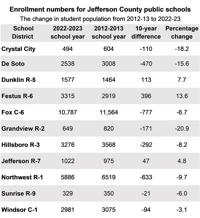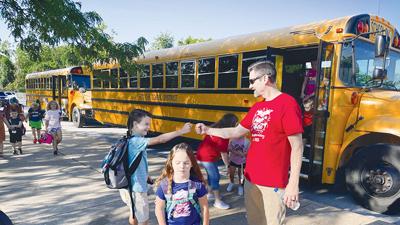Of the 11 public school districts in Jefferson County, eight have seen declining student enrollment over the past 10 years, which affects funding and school operations.
The Festus R-6 School District has by far seen the most growth in enrollment, with an increase of more than 13 percent since the 2012-2013 school year.
The Grandview R-2 School District has seen the largest decline in enrollment, with a decrease of 20.9 percent during the past decade, although students from across the state enrolled in an online school are considered Grandview students, complicating the enrollment story at that district.
After Grandview, the Crystal City School District has lost the largest number of students during the past 10 years, with an 18.2 percent drop, followed by the De Soto School District, with a 15.6 percent decrease.
Factors affecting enrollment include the area’s birth rate; the abundance or lack of new housing and job opportunities; and the population of residents who stay in the community after their children graduate from the district, school officials reported.
Those officials say they keep a close eye on enrollment since it affects the state and federal funding districts receive, as well as the amount of money districts spend on staffing and providing student services.
“We continuously monitor enrollment and trends to be able to make necessary adjustments in advance,” said Superintendent Josh Isaacson of the De Soto School District. “These adjustments include ensuring we have the proper staffing at all levels within the district to be able to provide the highest quality of learning for our students and community.”
Superintendent Nicki Ruess of the Festus Schools said increasing enrollment can be a double-edged sword.
“While more students in the district can translate into more funding from the state, based on student attendance, it creates facilities’ concerns, as rapid enrollment increases can lead to larger than desired student-to-teacher ratios in the classroom,” she said.
Some school officials, like those at the Fox C-6 School District, reported that COVID-19 has affected enrollment, although others said it didn’t have much of an effect on enrollment but did impact students’ learning and well-being.
“We did continue to see a decline in enrollment during COVID,” said Grandview Superintendent Matthew Zoph. “However, I think the biggest impact COVID had on our schools was social and emotional. Districts are expending resources to help struggling students and staff in ways I have never seen in my career. We are seeing more extreme student behaviors, depression, anxiety and drug use that we are having to adjust to.”
Enrollment is ever-changing, not just from year to year, but week to week. How much growth or decline a district experiences varies depending on the counting period the district uses to make future projections.
Some districts look at September data to analyze and make projections.
“Our data is pulled from the DESE (Department of Elementary and Secondary Education) website based upon the September membership period, which is the same count day each year required for districts to report to DESE,” Isaacson said. “We use one consistent day, time, and data set in order to be more accurate in our predictive modeling.”
The Dunklin R-5 School District has experienced significant enrollment growth (7.7 percent) over the past 10 years, but along with that increase in enrollment has come rising costs to educate students, school officials said.
“The cost to educate each child does rise with inflation,” said Dunklin communications director Matt Lichtenstein. “However, the formula for funding schools in our state is based on what Missouri says it costs to educate a child. This is known as the SAT, and it has remained at the same number of $6,375 for a long time, despite rising costs.”
Many district officials said they are keeping an eye on open enrollment legislation proposed this year, which, if passed, would allow students to transfer to schools outside the districts in which they live.
Northwest R-1 district officials have spoken out against the proposed legislation, House Bill 253. When that bill reached the House floor for live debate, state Rep. Gary Bonacker, also a Northwest school board member, spoke against it, arguing that the school district would be adversely affected by open enrollment.
“Northwest has three elementary schools that closely border the Rockwood School District (within 5 miles),” Superintendent Jennifer Hecktor said. “We believe we provide an excellent, well-rounded education to our students, but geographically, many families live far closer to Rockwood Summit High School than to our own high school that is located in Cedar Hill. We believe that schools are at the center of healthy communities and unify the community.”
Ruess said she, too, is concerned that open enrollment legislation could have several negative effects.
“The open enrollment legislation that has passed the House and is currently being considered in the Senate could directly impact enrollment for all districts in the state,” she said. “It could lead to less community support in a district as more students either transfer in from outside the community or students transfer out to another school, and they are no longer part of that community.
“That could make it more difficult for districts to pass ballot measures. With the uneven distribution of students who transfer, schools that lose students will likely have to cut programs because of the loss of state funds based on student attendance. Districts gaining students will likely see larger class sizes. The likely uneven distribution of transfers across the district will make it nearly impossible to add or eliminate positions based on lost/gained students.”
Ruess indicated it is difficult enough to predict and stay ahead of enrollment numbers based on students living in the district, and factoring in the unknown numbers of transfers in or out will make future planning even more challenging.

The following takes a closer look at enrollment at school districts around the county.
Crystal City
Crystal City School District’s enrollment has fluctuated.
“Our current enrollment is 494 students, as of our September count,” Superintendent Matt Holdinghausen said. “Our enrollment in 2013 was at 604.”
That’s an overall decrease of 18.2 percent.
“We lost enrollment when Jefferson R-7 built their high school (which opened in 2009),” he said. “Our enrollment has been declining since that time but has leveled over the last few years. I estimate it will continue to remain at the levels we are at now unless rules are changed by the Legislature with open enrollment.”
De Soto
The De Soto School District’s student enrollment was 3,008 during the 2012-13 school year, and the current enrollment is 2,538 students. That’s a 15.6 percent decline.
“As a district, we have seen a decline in enrollment over a 10-year period,” Superintendent Josh Isaacson said. “During this time, we have had to make adjustments … while still providing a high-quality education and providing competitive pay for all staff.”
With the decreasing enrollment comes declining funding, he said.
“We anticipate an approximate revenue decline from the 2023-2024 school year to the 2024-2025 school year in the amount of $1,686,454 based solely from our enrollment from state funds.”
Isaacson said he believes the school district will see growth again, though.
“We believe the pattern is a cycle that moves in one direction for a period of time and then swings the other direction for a period of time based upon house availability in our local area,” he said. “We are on the end of a 10-year cycle of decline and anticipate future growth, especially with the improvements we have seen in our schools and community over the past few years.
“Many families who live in the district have raised their children and are still in the area. As time continues in this cycle, houses will turn over and younger families will move into those houses to raise families. There are certainly areas in the county growing faster than others, which can have both positive and negative consequences for a district, as well as a community.”
Dunklin
The Dunklin R-5 School District’s highest enrollment during the past 10 years was in 2021-22 at 1,583, and this year’s enrollment is 1,577, a 7.7 percent growth from 10 years ago when enrollment was 1,464, school officials said.
“After 100 years of educating students, we are not concerned about shifts in our enrollment,” said Matt Lichtenstein, Dunklin’s communications director. “The district is home to a great community with affordable housing and easy access to I-55. We will continue to attract young families seeking quality schools.”
He said the district’s lowest enrollment over the past decade was during the 2012-2013 school year. “It was the first school year that Jefferson R-7 was no longer sending high school students to other districts (after phasing in classes over four years following the school’s 2009 opening).”
Lichtenstein said the district expects future growth.
“We are aware that new subdivisions are in the planning stages, and investment in a Herculaneum port will be a draw as well,” he said.
Lichtenstein said part of April’s bond issue will create additional classroom space in several buildings.
“It’s a proactive measure to ensure we’ll have the facilities to provide a great education,” he said.
Festus
Festus R-6 School District has experienced significant growth over the past 10 years, even through the pandemic.
“Our highest enrollment (over the past 10 years) is our current enrollment of 3,315 students,” said Ruess. “Our lowest was in the 2014-15 school year with enrollment of 2,915 students.”
Current enrollment is up 13.6 percent from 10 years ago when it was at 2,919, she said.
“We are always monitoring enrollment trends,” she said. “Over the course of the past few years, we have seen an average increase of approximately 100 students/year.”
Ruess said the growth can be attributed to several factors, including new housing built in the district.
“Our district is also a desirable place for people to move because of the district facilities, including the new Performing Arts Center, successful programs and activities and high student achievement in the classroom,” she added.
The district is planning for continued growth.
“That includes previous classroom additions to the high school and elementary school,” Ruess said. “The district is currently planning a two-phase classroom expansion. Phase 1 involves additional classrooms at the middle school, and the designs are nearly complete for that phase,” she said.
Phase 2 will include additional classroom space at the Intermediate School. That phase will begin once construction is underway for Phase 1.
Fox
The Fox C-6 School District, the largest school district in Jefferson County, has been on a downward trend. Ten years ago, enrollment was at 11,564, and the current enrollment is at 10,787, a 6.7 percent decline, school officials reported.
Superintendent Paul Fregeau said approximately 46 percent of Fox’s funding comes from the state, so any decrease in enrollment can negatively impact the district’s overall operating budget.
“Any fluctuations in enrollment make staffing a challenge,” he said. “We have to carefully monitor our enrollment and adjust staffing accordingly to ensure that we are responsible with our spending.”
Fregeau attributed at least part of a recent decline in enrollment to the COVID-19 pandemic.
“If enrollment continues to decrease, we will look at making adjustments to staffing to ensure we have the right number of staff serving Fox students,” he said. “We are currently awaiting the results of a demographic study that will help give a clear picture of where our enrollment can be expected to trend in the coming years. Once that study has been completed, we will be able to effectively plan for the coming years.”
Fox district officials announced in January that they planned to eliminate up to 27 teaching and three administrative positions through attrition to save about $2.4 million in salary and benefit costs during the 2023-2024 school year.
Grandview
Among Jefferson County school districts, the Grandview School District has unique circumstances related to student enrollment.
Due to a change in state law for the 2022-23 school year, any students in the state who are enrolled in the Missouri Virtual Academy (MOVA) – online public school for students in kindergarten through 12th grade – are considered Grandview students and show up on DESE enrollment numbers for that district.
“Our enrollment at Grandview is a little misleading,” Zoph said. “On-campus enrollment has dropped almost 100 students, going from 752 to 649 students over the past four years. Of these 649 students, almost 100 of them are tuition students we do not collect local tax dollars on.
“We also have included in our enrollment nearly 2,200 virtual students we collect a portion of their state aid but receive no local tax revenues on.”
Zoph said enrollment was 820 in 2014, so if you look at its 649 on-campus students, that’s a 20.9 percent decrease since then. However, if you include the virtual students, the district has seen a 253 percent increase.
“In the past 10 years, we have gone from cutting a teacher per grade level, to starting to add those teachers back as our enrollment slowly begins to increase,” he said.
“There was a study done (about 10 years ago) that classified the area of our district as a dying community . . . and we have seen a steady decline during that 10-year period.
“Luckily, we are finally starting to see a change in those trends in our elementary school and are projecting growth for the next seven or eight years. I truly believe that we have hit our low and are now starting to trend in the right direction. Unfortunately, it may take a decade to get back to our previous on-campus numbers.”
Zoph said he believes the online school “will be a huge benefit in the long run.”
Hillsboro
Hillsboro Superintendent Jon Isaacson said the district’s enrollment was at its highest in 2006 with 3,717 students, and it’s at its lowest this school year with 3,276 students, down 8.2 percent from 10 years ago when enrollment was 3,568.
In a recent report to the school board, Isaacson projected enrollment would continue to decline through 2027, to an enrollment of 3,087 students.
“Birth rates and available housing have the biggest impact on enrollment,” he said. “There is no significant number of vacant homes within the district and no new housing developments for families with school-age children to move into. The overall birth rate in Jefferson County has continued to decline.
“From the 2023-2024 school year to the 2024-2025 school year, we anticipate an approximate state revenue decline of $1.5 to $1.7 million based solely from our decline in enrollment.”
Isaacson said the district expects a continued decline in enrollment over the next five years, although growth is possible.
“In the short term, we anticipate a continued decline as we graduate with some larger class sizes,” he said. “However, the potential for growth is there due to the amount of vacant land within our district boundaries (where development may occur).”
Jefferson
Student enrollment in the Jefferson R-7 School District has climbed about 4.8 percent over the past 10 years, Superintendent Clint Johnston said.
He said the enrollment was 975 10 years ago and currently is at 1,022, down just 13 students from the year before.
Johnston said the district’s enrollment has been consistent with growth and any increases or drops with class sizes are related to the birth rate.
Northwest
Enrollment at the county’s second largest school district, the Northwest R-1 School District, has been on the decline.
This school year, the district has 5,886 students, down 9.7 percent from 10 years ago when it was at 6,519.
“The Northwest R-I School District was largely affected by the closure of the Chrysler plant in Fenton in 2010,” Hecktor said. “The closure of the plant resulted in a loss of jobs for members of our community.
“Along with the national birthrate being down, we have an aging-in-place population. In some communities, when students graduate, parents sell their homes and move to a new area. For our area, as students graduate and move away from home, their parents are staying in the district. This speaks well of our communities and represents that our area is a beautiful setting in which to live, play, raise a family and stay.”
Despite the declining enrollment, the district’s funding is fairly stable since it is considered a “hold harmless” district, which means it won’t receive less state aid than what was provided during the 2006-2007 school year, Hecktor said.
“There are components of the formula that do affect our funding based on enrollment, but our enrollment is steady and predictable. which makes short- and long-term budgeting easier,” she said.
“As our enrollment decreases, we use attrition (resignations and retirements) to adjust sections of classes as is appropriate. We have some new subdivisions in our area, so we believe that our enrollment will level out or decrease at a lesser rate in the future.”
Sunrise
The Sunrise R-9 School District, which is the smallest school district in the county and enrolls students in kindergarten through eighth grade, hasn’t seen big changes in enrollment over the past decade, Superintendent Armand Spurgin said.
He said the enrollment has fluctuated between 325 and 350 over the past 10 years.
Despite a 7 percent change from lowest to highest, Spurgin said the enrollment numbers are relatively steady and aren’t much of a concern.
He also said he expects numbers to stay stable over the next five years.
“We feel Sunrise experiences a normal range of enrollment ups and downs,” he said.
Windsor
Windsor C-1 School District’s enrollment has declined slightly, from 3,075 students 10 years ago to the current 2,981, a 3.1 percent drop, district officials reported.
“We continuously monitor enrollment trends in the hopes of being proactive in making necessary adjustments,” Superintendent Jason King said. “These include adjustments in staffing decisions, budget and educational programming.”
King, who became Windsor’s superintendent this school year, said the district has done a good job working through the decrease in enrollment while still providing a high level of learning for students and a competitive level of pay for staff.
“We believe that future growth is on the horizon with additional housing and employment opportunities throughout the district,” he said. “Enrollment tends to swing both ways over a period of time. The Windsor C-1 School District encompasses an area that is wonderful for living, working and building a family. Most importantly, it is a fantastic place for children to receive a great educational foundation for future success.”







